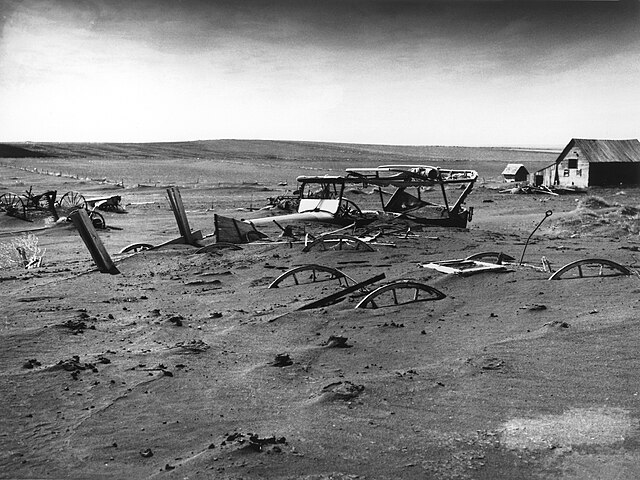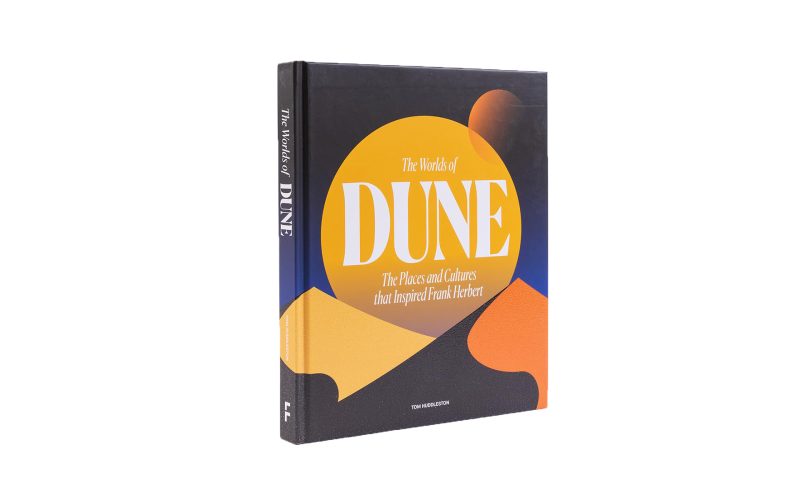Tom Huddleston’s The Worlds of Dune: The Places and Cultures that Inspired Frank Herbert (2023) is a beautifully designed book that explores the range of ideas and concepts that inspired Frank Herbert in the writing of his 1965 science fiction masterpiece, Dune. Through an introductory biography chapter followed by twelve chapters named after planets, characters, and other elements in Dune, Huddleston looks at various political, environmental, and social influences that help show the many layers of meaning in Herbert’s complex novel. Each chapter is accompanied by images from art history, film, books, comics, and photographs that bring the story to life and provide additional food for thought.
When I first picked it up, I was surprised to find a gritty texture covering the sand dunes on the cover. This three-dimensional feel—alongside the layout, paper, and images chosen—gives the book an impressive high-quality, coffee-table style. Although I prefer serif font, the text is well-organized and has pull quotes to highlight key points, as well as unobtrusive endnotes pointing toward a reference list with sources and additional info.
As a film and TV writer and an author of sci-fi and fantasy novels for younger readers, Huddleston took on a hefty subject for what he identifies as his first longform non-fiction work. Fortunately he put in the effort to give this book the needed research backing and accuracy, with material from external sources blended with his own commentary and observations. (I also should note that I provided feedback suggestions during the writing process.) I was delighted to learn or relearn some things about Dune and make new connections that might fuel further pathways of research for myself and other writers.
What’s inside
The introductory chapter provides a brief biography of Herbert to set the scene. We learn about his childhood, marriages and family, travel, jobs, foray into science fiction, and later life. The next chapter takes us to the influences on Arrakis, the desert planet at the heart of Dune. Huddleston touches on earlier works by writers such as Edgar Rice Burroughs, Paul Bigelow Sears, and Rachel Carson and their perspectives on imaginary and real landscapes and ecology. The images of the American Dust Bowl of the 1930s paint a stark picture of the devastation that sand can bring. This chapter also looks at the influences on the sandworm and the stillsuit.

Chapter Two moves into an exploration of what inspired the Fremen. Lesley Blanch’s The Sabres of Paradise makes a strong appearance, as do numerous Arabic and Native American influences. Chapter Three examines the spice mélange and its connections to hallucinogen drugs, oil in the Middle East, extra-sensory perception, and Heisenberg’s uncertainty principle.
Chapter Four moves into Caladan and some of the influences behind names such as Atreides, Caladan, and Duncan. Huddleston looks at the significance of bullfighting—a symbol in Dune—and Shakespearean characters and themes. Chapter Five centers on Paul and the history of the Mahdi figure in the Middle East and the problematic nature of white savior narratives. Huddleston provides nuance to this discussion of the influence of T.E. Lawrence, and I appreciated that he mentions the historic overlooking of other figures such as Gertrude Bell in the story and myth of Lawrence of Arabia.
The next chapter, Chapter Six, moves on to a discussion of Lady Jessica and the Bene Gesserit, and the complicated place of women in the story of Dune. Huddleston acknowledges the sacrifices that Herbert’s spouse Beverly made to enable his writing career, and that appearances can be deceiving when it comes to analyzing this highly skilled yet secretive Sisterhood. Citing some of my work on the Bene Gesserit, including their influence by the Jesuit order, Huddleston looks at Eastern practices and belief systems and how they relate to these women. He does a particularly fine job of elaborating on the role of general semantics—a topic that’s complex and hard to make accessible—and exploring problematic eugenics thinking and the contradictory ideas at play in Dune.
In Chapter Seven, he looks at House Harkonnen and the model of depraved dictator Caligula, which has not been discussed much in relation to Dune. He makes the case for several connections between these figures, and also examines the influence of the Cold War on these vile villains. Chapter Eight moves on to the Mentats and the influence of Samuel Butler’s Erewhon and Herbert’s distrust of technology. I liked that Huddleston acknowledges the role of women ‘computers’ at NASA and Herbert’s clever grandmother, alongside other possible influences such as Sherlock Holmes. Chapter Nine focuses on CHOAM and the linkages with OPEC, and how eerily prophetic Dune is for anticipating the fights over resources that would dominate the second half of the 20th century. Huddleston also reaches back to look at the Dutch East India Company and their strengths as a powerful mercantile organization in the 1600s and 1700s.
Chapter Ten examines House Corrino and the Emperor and how they relate to Herbert’s views on power and government. Ibn Khaldun makes an appearance, as do historic fighting forces such as the fighters of Sparta and the Roman Praetorian Guard. Huddleston dives into the history of the Janissaries, the feared fighters of the Ottoman Sultan, as another possible influence on the development of the Sardaukar in Dune. In Chapter Eleven, Huddleston writes about the Landsraad and the connections with feudal European society. There are the usual generalizations about feudalism which are hard to avoid, but this chapter still captures the ideas in popular culture that likely influenced Herbert’s construction of the feudal structure in Dune. It also touches on the idea of kanly or vendetta, still popular in films such as The Godfather Part II and Gomorrah.
Chapter Twelve discusses the Spacing Guild and a potential influence in the mysterious Freemasons. I found this an interesting avenue of exploration and am still wondering why screen adaptations feel the need to show the Navigators in such detail rather than let them stay mysterious. Huddleston returns to the influence of Edgar Rice Burroughs and his tales set on Mars, as well as writers Jack Vance and Poul Anderson, who were close personal friends of Herbert. This chapter also looks at the role of Isaac Asimov and the Foundation series, which prompted Herbert to explore an alternative vision of the decline of empire and the role of prescience.
Huddleston closes the book with an epilogue about the cultural impact of Dune, from its film adaptations (made and unmade) and video games, to music and books and films inspired by it. With Herbert’s work still inspiring artists and scientists, Huddleston shows the significant impact Dune has had and continues to have long after Herbert first sat down to research and write.
As the third mass-market book on the topic of Dune in the last month, The Worlds of Dune again proves there is much to be said about this bestselling science fiction story and its impact in the world. Huddleston navigates the complexities of the many influences on Herbert’s work in a way that’s accessible and avoids overwhelm. This book will pique your interest in returning to the source material and finding out more about the writers, historical events, and other influences that helped make Dune a many-layered, world-building masterpiece.
You can find Tom Huddleston’s The Worlds of Dune: The Places and Cultures that Inspired Frank Herbert on Amazon. Thanks to Huddleston and the publisher Frances Lincoln for reaching out for my expertise and providing a review copy of the book.
Note that some links on posts are affiliate links so I may earn a commission if you use them to complete a purchase.


